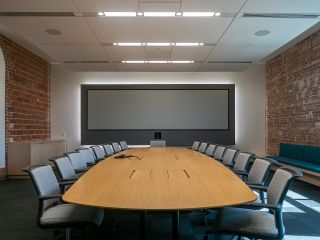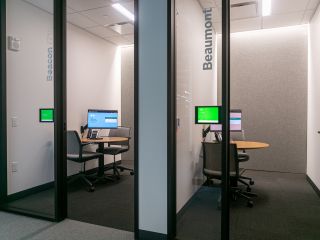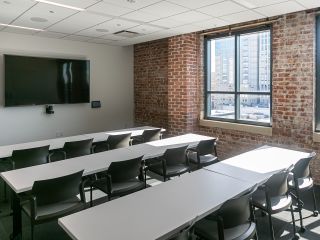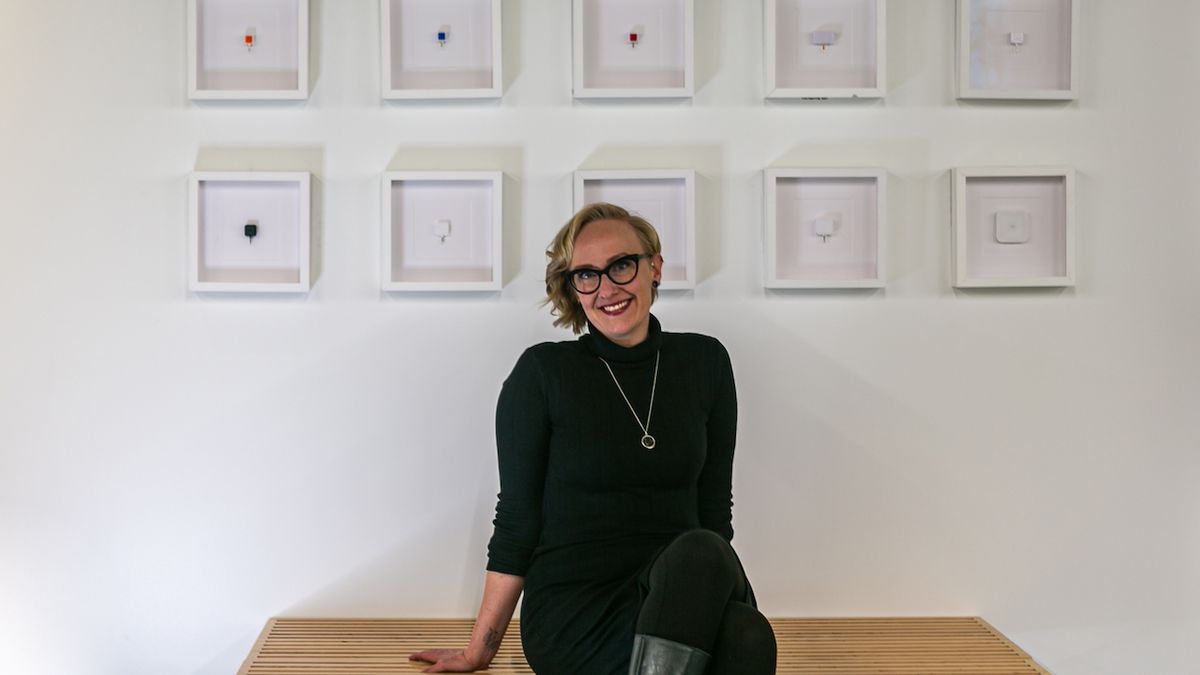When it comes to innovation, Square practices what it preaches. The fintech giant helped to democratize transactions with the debut of its ubiquitous Square reader and the myriad solutions that have followed. Point of Sale (PoS), hardware, software, apps, services—if it can help a business grow, Square’s got it. The company continues to roll out new tools that harness the potential of the digital revolution and empower businesses in dramatic new ways.
It's therefore no surprise that Square attracts talent who think boldly, not just about today’s problems, but about what’s possible. Laura Talon, one of Square’s senior AV engineers, is such a visionary. With a diverse background, including work in audio production, UX tech at Google, and audiovisual technology at Twilio, Talon is leveraging pro AV systems and tools to help Square’s teams thrive.
Addressing the ripple effects of the COVID pandemic, enhancing the remote work experience, combating screen fatigue, and making AV “invisible” are some of the pressing concerns for technologists this year. For Laura Talon and Square’s AV team, it’s game on.
AV Standards
During her tenure as an AV lead at cloud communications company Twilio, Talon realized the vital importance of AV standards. “I was doing their events,” she explained, “all of the break/fix, all of the build-outs for AV—for the company, with 24 offices worldwide at the time.”
She created standards to help bring efficacy to various AV processes. Rather than an immutable formula, Talon suggests a “skeleton to start with, to hold everything else in place, as well as modular AV standards for rooms that fall outside the standard.”
Whether the standards apply to larger, complex spaces, or smaller rooms in which all-in-one systems might suffice, AV components must always “do their job,” Talon asserted. “That is what we want—AV to work, and to work reliably.”
Building AV systems that perform flawlessly, every time, requires a specific recipe: technical acumen, creative vision, and knowledge of user needs and workflows. Context is key.
“Don’t outsource AV,” Talon warned. More often than not, rooms that were “afterthoughts,” or AV that was procured only because it was cost effective create spaces that “don't sound good,” she said. “They don't look good. They are marginally functional. And half of them are down. You need somebody who is ‘AV invested’ in every company.”
Expertise Matters
To that end, Talon appreciates Square’s dedication to specialization, with teams organized around areas of expertise and centers of gravity.

“I strongly feel that AV is not IT,” she said, “and we're usually thrown under IT. At Square, we have what's called Business Technology, within which we have subject matter experts. We have a networking team, a security team, and an awesome AV team. I love it. We don’t expect the IT person to do everything, nor should we.”
Bye, Boring Conference Room
The industry had been trending away from traditional conference room setups for years. The global pandemic hastened the shift. “Moving forward, we will have a hybrid work model,” Talon said. Last summer, Square announced that Square employees will be able to work from home permanently, even once offices begin to reopen.
After the dust settles from the Coronavirus crisis, will companies want to pack people into a boardroom again, just like the days of yore? Talon says no: “Companies will want different types of rooms. There’s a focus on incredibly collaborative spaces, and that means more comfortable spaces.”
Talon emphasized the relationship between the external and internal, noting that our surroundings can influence people in profoundly different ways.
“At Square, we’re focused on designing more collaborative spaces, with great seating—more like a living room feel—a space where you can be comfortable and enjoy being there,” she said. “You won’t have to feel ‘buttoned up,’ and you're not expected to behave. You're expected to innovate.”
Invisible AV
Talon added that AV should not be a focal point, it should be a tool. “It should be there when necessary,” she opined. “It should be incredibly functional, offer a lot of flexibility and options, and it should be highly collaborative. It should allow for simultaneous whiteboarding, on the same whiteboard, for remote teams and people in the physical [office]. We want to create spaces where people can actually get work done rather than just talk about getting work done.”
AV over IP: A Cleaner Experience
To create spaces that are extremely flexible, ergonomic, and aesthetically appealing, AV-over-IP designs make sense. Talon admittedly loves Genelec. “I have been using their speakers forever, and I think it's the most beautiful reference speaker I've ever used,” she said. “Especially the design capacitor that allows you to get the power you need over IP, which I'm impressed by. I have this thing running off this tiny little Netgear switch, and it's just exactly as I’d expect it to sound—amazing”

IP-enabled AV solutions like Genelec speakers typify “where we're going,” she said. The AV-over-IP methodology saves money on installation, because you're not running as many cables. It provides a cleaner experience and a cleaner installation. “We want to be able to use AV, but not see it,” she stated. “AV over IP enables this. We can tuck components away and make them as visually unobtrusive as possible. I am also a big fan of cable management,” she enthused.
Human Focused
It’s crucial to “design around users,” Talon emphasized, rather than designing systems in a vacuum or on specs alone. “I love talking with users and understanding their workflows, what they're doing in a room, and actually working with them.”
For Talon, listening is deeply generative and essential to the work of AV: “A lot of my ideas and innovation comes from listening to users and asking them questions.”
Hybrid Future, But Immersive
Even with a hybrid workforce, we will need AV-rich spaces. Talon strongly dismisses the notion that corporate AV is in danger. “We're still going to need AV, but we have to level the playing field for people working from home. For whiteboarding and other team-focused work, we use various collaboration tools, so everyone—onsite or online—can whiteboard together. I think we’ll continue to see more of that.”
Square is committed to keeping employees safe in the office, so Talon hopes to design AV spaces that allow for social distancing and touchless AV options, like voice control and occupancy sensors, or BYOD personal device control. Single-occupancy, non-bookable spaces for quick meetings, for instance, could be useful. PTZ and auto-tracking cameras will help bridge the onsite teams with remote workers.
Emerging Tech
Square is not deploying VR or AR solutions on the corporate level at the moment, but Talon is personally intrigued by the possibilities for the industry. “Experimentation is important,” she said, suggesting that AV has to adapt to broader trends and innovations.
What interests Talon about VR conferencing is how it can let employees be themselves—ironic, because virtual reality interactions are wholly digital. Nonetheless, “in a VR conference,” she said, “I can go in there as a seven-foot-tall pink rabbit and still be professional, which thrills me.”

As the world begins to emerge from the Coronavirus pandemic, many people are still feeling “screen fatigue.” Videoconferences can feel monotonous; focused eye contact can indeed be exhausting. Conversely, with VR and AR conferencing, “you could go into an adorable eight-bit environment with a customized town, or you could be in this fully immersive, amazing, beautiful VR space. It’s relaxing and freeing; in general, when people are relaxed they think differently and that promotes innovation.”
Vendor Relationships
As an AV engineer who works with “a variety of integration partners, because they all have specialties,” Talon appreciates the chance to connect with manufacturers directly: “I'm not thrilled with sales pitches, but it is really important to have vendors explain their products, and to interact with the technology before you can say, ‘Okay, this is right for my entire company.’”
AV is For All of Us
Despite commendable efforts to diversify the professional AV industry, women currently comprise less than 20 percent of the workforce. Laura Talon is passionate about making the industry more inclusive.
She also wants to share the virtues of AV with the wider world, particularly underrepresented groups. “Women should know that this is a fun industry to be in,” she said, “and ‘I bet you would be really good at it.’ Every woman I know in this industry is amazing. This work is highly technical, and it’s also very creative too. I can spec speakers, but I also pick colors for speakers. I get to work with design and furniture. AV is so much more than just working on a conference room.”
Margot Douaihy, PhD, teaches at Franklin Pierce University in New Hampshire.














